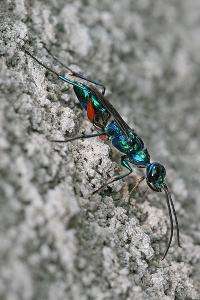January 8, 2013 report
Researchers discover wasp larva disinfect their food before eating

(Phys.org)—A team of German researchers has discovered that emerald cockroach wasp larva create a disinfecting clear liquid solution in their mouths that they spit out and use to disinfect their food before eating. This is especially important the team notes in their paper published in the Proceedings of the National Academy of Sciences, because the larva live inside the body of a cockroach.
Scientists have known for some time that the emerald cockroach wasp has special abilities that allow it to survive – it stings a cockroach twice, once to stun it, and then again to make it docile and then lays an egg on its leg that eventually hatches and bores its way into the hosts body. The larva then lives out its life inside the cockroach, using it as both cradle and food source. Now it appears, the wasp larva has a special ability of its own.
The researchers cut out a small section of the side of a parasitized cockroach and installed a small window. This allowed them to watch the larva inside as it went about its business. They were surprised to find that the larva spewed a liquid out of its mouth and then used it to cover the insides of its host before eating. Their curiosity piqued, the researchers examined the liquid more closely. They found that it contained micromolide and mellein – substances that are known to work as antibacterial agents.
Cockroaches are obviously very dirty little bugs and they harbor all manner of viruses, bacteria and fungi. One bacterium commonly found on many species is Serratia marcescens – it's particularly lethal to wasps; for a larva to live inside a cockroach would require some degree of sanitizing. To address the problem, nature has provided the larva with the means of creating its own disinfectant, which also serves as a preservative – no bacteria, no rotting.
The team also tested the effectiveness of the antibiotic fluid, dousing bacterial cultures with samples and found it killed off a wide variety of bacteria. They also collected cockroaches in the wild, comparing those that had been parasitized with a larva and those that had not. Those with larva in them showed evidence of the bacterial compound created by the larva, while those that were not parasitized, did not, proving that larva were in fact the source of the antibacterial agents.
More information: Larvae of the parasitoid wasp Ampulex compressa sanitize their host, the American cockroach, with a blend of antimicrobials, PNAS, Published online before print January 7, 2013, doi: 10.1073/pnas.1213384110 . www.pnas.org/content/early/201 … /1213384110.abstract
Abstract
Food resources contaminated with spoilage or pathogenic microorganisms pose severe problems to all higher organisms. Here, we describe a food-hygienic strategy of the emerald cockroach wasp Ampulex compressa. The wasp larvae develop on and inside the American cockroach Periplaneta americana, a host that can harbor various putrefactive microbes, as well as human and insect pathogens. From P. americana, we isolated the Gram-negative bacterium Serratia marcescens, which is a potent entomopathogen that can rapidly kill insect larvae. It is also known as a food contaminant and as an opportunistic human pathogen. Using behavioral observations and chemical analyses, we demonstrated that A. compressa larvae impregnate their cockroach hosts from inside with large amounts of an oral secretion containing a blend of γ-lactones and isocoumarins with (R)-(-)-mellein [(R)-(-)-3,4-diydro-8-hydroxy-3-methylisocoumarin] and micromolide [(4R,9Z)-octadec-9-en-4-olide] as dominant components. We fractionated hexane extracts of the secretion and investigated the antimicrobial properties of the fraction containing the lactones and isocoumarins, as well as of synthetic (R)-(-)-mellein and micromolide, against S. marcescens and a Gram-positive bacterium, Staphylococcus hyicus, in broth microdilution assays. The test fraction inhibited growth of both tested bacteria. The activity of the fraction against S. marcescens was explained by (R)-(-)-mellein alone, and the activity against S. hyicus was explained by the combined action of (R)-(-)-mellein and micromolide. Our data suggest that the specific combination of antimicrobials in the larval secretion provides an effective frontline defense against the unpredictable spectrum of microbes that A. compressa larvae may encounter during their development inside their cockroach hosts.
Journal information: Proceedings of the National Academy of Sciences
© 2013 Phys.org



















